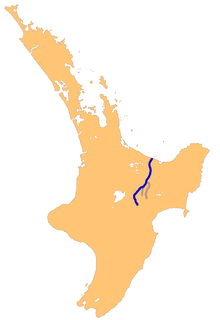
The Chatham Islands, part of New Zealand, form an archipelago in the Pacific Ocean about 800 kilometres (500 mi) east of the South Island. The archipelago consists of about ten islands within an approximate 60-kilometre (37 mi) radius, the largest of which are Chatham Island and Pitt Island. They include New Zealand's easternmost point, the Forty-Fours. Some of the islands, formerly cleared for farming, are now preserved as nature reserves to conserve some of the unique flora and fauna.

The Moriori are the indigenous Polynesian people of the Chatham Islands, New Zealand. Moriori originated from Māori settlers from the New Zealand mainland around AD 1500. This was near the time of the shift from the Archaic to Classic Māori culture on the main islands of New Zealand. Oral tradition records multiple waves of migration to the Chatham Islands. Over several centuries these settlers' culture diverged from mainland Māori, developing a distinctive dialect, mythology, artistic expression and way of life.

Chatham Island is by far the largest island of the Chatham Islands group, in the south Pacific Ocean off the eastern coast of New Zealand's South Island. It is said to be "halfway between the equator and the pole, and right on the International Date Line", though the point in fact lies ca. 173 miles WSW of the island's westernmost point. The island is called Rekohu in Moriori, and Wharekauri in Māori.

The Rangitaiki River is the longest river in the Bay of Plenty region in New Zealand's North Island. It is 155 kilometres (96 mi) long, and rises inland from northern Hawkes Bay to the east of the Kaingaroa Forest. The Rangitaiki catchment covers an area of 3005 km2. It flows in a generally northeastward direction, passing through the town of Murupara and skirting close to the western edge of Te Urewera National Park before turning northwards, flowing past Edgecumbe and into the Bay of Plenty close to Thornton.

Murupara is a town located in the Whakatane District and Bay of Plenty Region of New Zealand's North Island. The town is situated in an isolated part of the region between the Kaingaroa Forest and Te Urewera National Park, on the banks of the Rangitaiki River, 65 kilometres southeast of Rotorua.

Kaingaroa Forest covers 2900 km² of the Bay of Plenty region of New Zealand, and is the largest forest plantation in New Zealand, and the second largest in the Southern Hemisphere. The forest stretches from Lake Taupo in the south to Kawerau to the north. The headquarters of the forest are at the small settlement of Kaingaroa, 50 kilometres southeast of Rotorua. Prior to planting the area was a tussock and scrub plateau, formed on volcanic ash.

Waitangi is the main port and settlement on the Chatham Islands. It is located on the southern shore of Petre Bay, on the west coast of the main island. This community is by far the largest settlement in the archipelago, with a population of about 250, about 40% of the group's population, estimated in 2016 to be 610. The population has been decreasing but has stabilized over the last four years.
Kaingaroa is the name of several places in New Zealand:

Edward Robert Tregear (1846–1931) was a New Zealand public servant and scholar.

Torotoro National Park is a national park and town in Bolivia. The town was founded about 250 years ago by the Quechuas and the Spanish. It is located in the eastern mountain ranges of the South American Andes cordilleras in the area of Potosí.

Toro Toro is a town in the Charcas Province, Potosí Department, Bolivia.

The yellow-billed kingfisher is a medium-sized tree kingfisher.

The Reporoa Caldera is a 10 km by 15 km caldera in New Zealand's Taupo Volcanic Zone. It formed some 230,000 years ago, in a large eruption that deposited approximately 100 km3 of tephra, forming the Kaingaroa Ignimbrite layer. It contains three rhyolitic lava domes and is associated with three geothermal fields. These are the active Reporoa geothermal field in the caldera, The Waiotapu geothermal area north of the caldera rim, and the Broadlands thermal area to the south. The Waikato River runs through the southern half of the caldera.

Reporoa is a rural community in Rotorua Lakes within the Waikato region of New Zealand's North Island.

Galatea is a settlement in the Whakatane district in the Bay of Plenty region of the North Island of New Zealand.

Ngāti Manawa is a Māori iwi of New Zealand.

Rangitahi Lake is located in the Chatham Islands of New Zealand. It is located on Chatham Island, to the northeast of Te Whanga Lagoon, close to the northern end of Hanson Bay.

HMS Torch was an Alert-class sloop of the Royal Navy, built at Sheerness Dockyard and launched in 1894. She served in Australia and New Zealand and was transferred to New Zealand as a training ship in 1917, being renamed HMS Firebrand at the same time. She was sold in 1920 and converted to a refrigerated ship with the new name Rama. She ran aground in the Chatham Islands in 1924 and was abandoned.
The Murupara Branch is a branch railway line from the East Coast Main Trunk at Hawkens Junction near Edgecumbe via Kawerau to Murupara; built to serve a new pulp and paper mill harvesting the radiata pine trees of the Kaingaroa Forest on the Kaingaroa Plateau in the Bay of Plenty, New Zealand. The line was the last major extension of the NZR network; of 14 km from Hawkens Junction to Kawerau and 57 km from Kawerau to Murupara. The portion from Hawkens Junction to Kawerau is now officially part of the East Coast Main Trunk.
This page is based on this
Wikipedia article Text is available under the
CC BY-SA 4.0 license; additional terms may apply.
Images, videos and audio are available under their respective licenses.

















